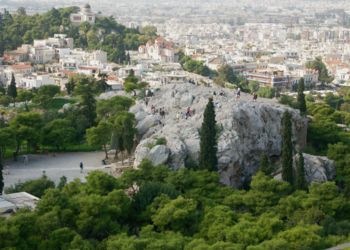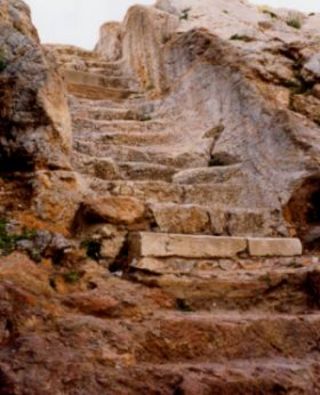Areopagos
Near the Acropolis on the South (?) side is the Areopages. Areopagos? Literally, hill of Aries, the God of War. It is a big slippery rock. Rock? As in limestone. While it is a steep climb from the Acropolis side once ascended there is a vista of Athens and one realizes that the Areopagos is a foothill of the Acropolis. On all of this and more go to friend Wikipedia http://en.wikipedia.org/wiki/Areopagus

On top the Areopagos in the Classical Age was a meeting house, no not a Quaker hall, but a building where various councils meant. Accordingly, a lot of the famous names climbed the slippery steps that go up the slippery rock, which are now even more well worn with two thousand years of tourists climbing them, including Hadrian and probably other Roman emperors, as I recall Alexander the Great never went to Athens so he did not.

We ascended in the twilight and took in the view. No remains remain of the building(s) but the plateau is larger than it seems from the Acropolis side. There is plenty of room, though there are sheer drops and not a safety rail to be seen or even a cautionary sign, or for that matter, any sign at all. We were quickly satisfied and left.
There is a steel staircase as well. Kate used that going up but I thought this was another chance for me to walk where others had walked in the pilgrimage, Kimon, Themistocles, Callicles, Pericles, and others, so I used the stone steps which were no doubt hacked out by Greek slaves in 500 B.C. or so.
Slave labour reminds of a musing I had in Nashville that I did not blog. The state capitol is on an imposing hill and it was completed in 1859. http://tennesseeencyclopedia.net/imagegallery.php?EntryID=T061 It is very likely all the hard work of digging into that hill and laving the foundation of that building was done by slave labour. While a sign on the front proclaims proudly the history of Tennessee statehood it says not a word about how the building was built.
